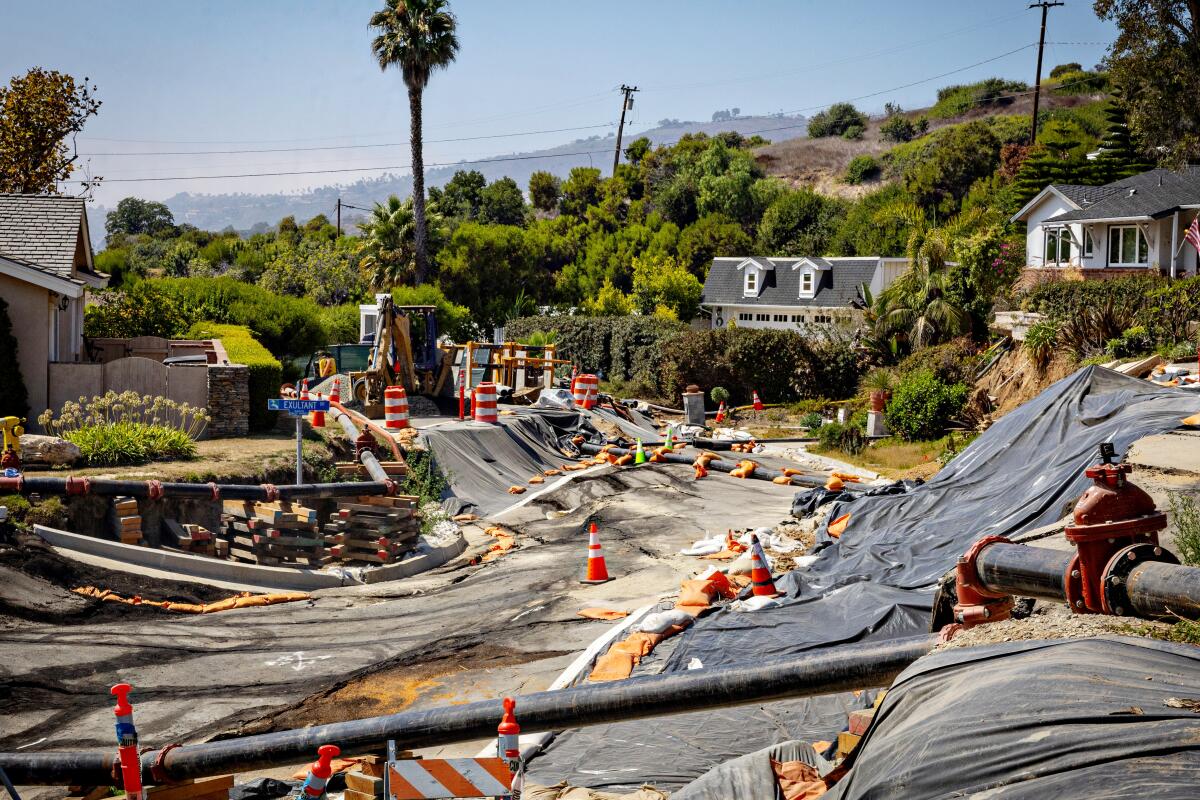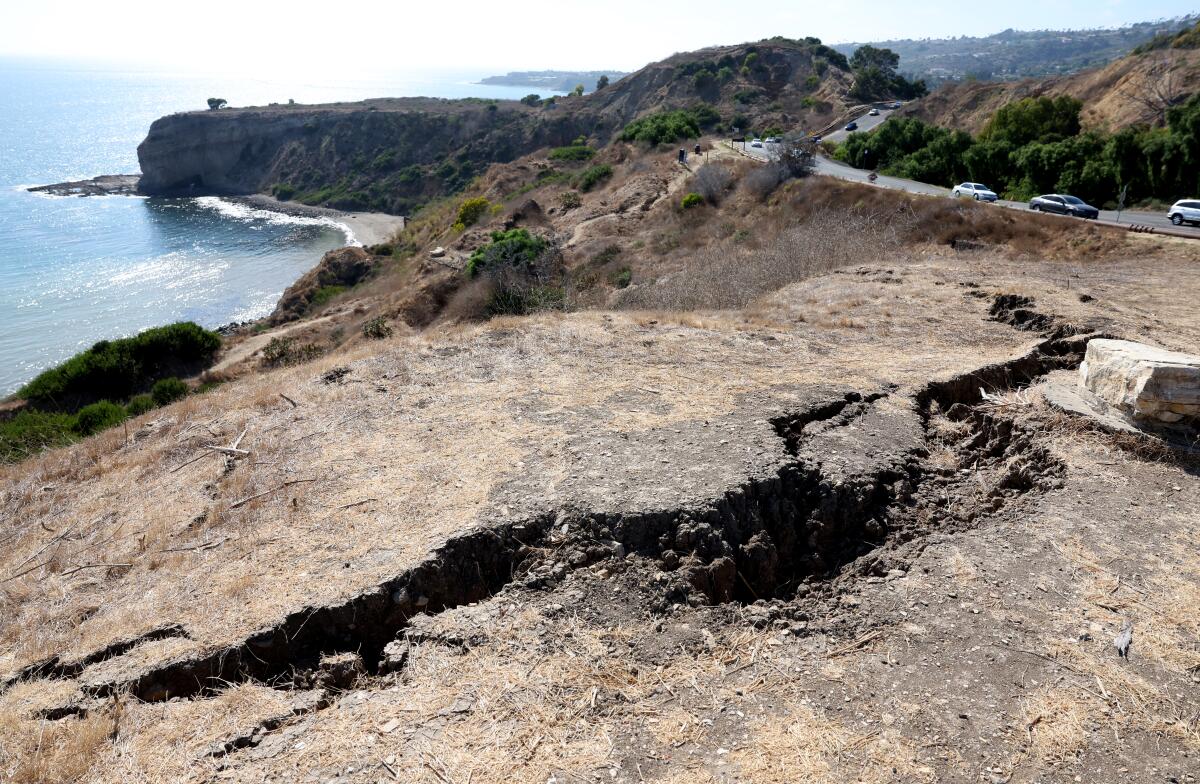Good morning. It’s Tuesday, Sept. 24. Here’s what you need to know to start your day.
Landslide risk in Rancho Palos Verdes is expanding. Can the city stop it?
The Palos Verdes Peninsula features pricey homes and stunning views of the Pacific Ocean. But for decades, residents there have contended with a geological fact: The land they live on is sliding toward the sea.
What had long been treated as a slow-moving crisis has accelerated in recent months, as the cities of Rancho Palos Verdes and Rolling Hills face an active complex of landslides. Movement that had taken months or years is now taking weeks in the area called Portuguese Bend, damaging and destroying homes, collapsing roads and creating brand-new beaches.
The increasing landslides have left hundreds of homes in the city of Rancho Palos Verdes without electricity, gas or both as utility companies shut off service over concerns of ruptured pipes, fires and other hazards.
The city issued an evacuation warning for some neighborhoods, though many residents have decided to stay put, relying on generators to keep their lights on and appliances running. Some homes in the neighboring city of Rolling Hills are also without power.
“Amid the long list of challenges now accompanying daily life in their Portuguese Bend community, the predominant feelings among many residents are mounting anxiety and frustration — and even anger — over a lack of responsibility, answers or assistance from anyone in charge,” my colleagues Grace Toohey and Karen Garcia reported.

(Jason Armond / Los Angeles Times)
What is the city doing about this?
Officials are working to slow the landslide, which has accelerated due to increased groundwater made possible by two straight winters of heavy rain after years of drought. All that water is putting pressure on the deep landslide plane.
So the goal now is to relieve that pressure by drilling dewatering wells and pumping out the groundwater. Two wells have already been installed, according to city officials, pumping about 200 gallons of water per minute combined. Three more wells are expected to be drilled in the next week.
Will it work? The technology has helped slow other landslides, but it’s unclear what effect these wells will have.
Gov. Gavin Newsom declared a state of emergency for Rancho Palos Verdesthis month, which provides funding for the groundwater mitigation efforts and support for local authorities.
But some residents feel the state and local government aren’t doing enough.
“The governor, he hasn’t even seen” the damage, resident Steven Barker told Karen and Grace. “He should be here, this is way bigger than RPV can handle. Way bigger than the utility companies. .... We need Army Corps of Engineers.”

A huge crack forms along Palos Verdes Drive South in Rancho Palos Verdes where a landslide has accelerated at the end of August. (Wally Skalij / Los Angeles Times)
Portuguese Bend has been sliding for over half a century
The area is part of the larger ancient landslide zone that comprises the southern section of the Palos Verdes Peninsula. It had been dormant for thousands of years but was reactivated in 1956 by human development.
The building continued with pricey hillside homes going up in what would become the cities of Rancho Palos Verdes and Rolling Hills. So did the landslides, which, before the recent crisis, were moving parts of the peninsula up to 8.5 inches each year.
“Landslides are common, but what makes Portuguese Bend’s extraordinary is how slowly but surely it persists — the Aesop tortoise of natural disasters,” Times reporter Jack Flemming wrote in March 2023. “Scientists and geologists have flocked to the area over the years to study the slide because of its rare combination of size and scope.”
But now, some areas are seeing more movement than that each week — up to 13 inches, Grace reported last month.
Some residents have vowed to stay put. But with the situation growing worse in recent weeks, it begs the question: Is their resolve fueled more by hope or hubris?
Jack unpacked that in a story last year exploring why Californians continue to live in places prone to disaster.
“I’ll be here until I can’t be here anymore,” one longtime resident told him shortly after several Rolling Hills homes collapsed into a canyon in July 2023. “I’ll slide away with the land.”
Today’s top stories

Plastic is loaded onto a conveyor belt at ExxonMobil’s chemical recycling plant in Baytown, Texas. (Sergio Flores / AFP/Getty Images)
California sued ExxonMobil for allegedly misleading the public about plastic recycling
- In the first lawsuit of its kind, California Atty. Gen. Rob Bonta alleged ExxonMobil Corp. carried out a “decades-long campaign of deception”over the potential for plastic recycling and created an environmental blight that has cost the state billions of dollars to clean.
- The lawsuit comes amid a growing body of research showing the harmful effects of microplastics in the environment and within human bodies.
- In other environmental news, Gov. Newsom’s office announced a new campaign to encourage 1 million Californians to take everyday actions to help combat climate change.
A new COVID subvariant poses a potential threat heading into winter
- The subvariant XEC was first detected in Germany and is gaining traction in Western Europe. Previous surges have tended “to move from Western Europe to the East Coast to the West Coast of the U.S.,” a health expert said.
- Worried that XEC could reverse recent promising transmission trends, doctors are renewing calls for residents to get an updated vaccine.
- Meanwhile, free COVID tests are coming back. Here’s how to get yours.
California’s underground puppy trade ‘raises serious alarms’ and demands for state action
- Lawmakers and animal welfare advocates said California must stop purging health records that could help trace dogs back to puppy mills.
- Many dogs sold as California-bred come from mass breeders in the Midwest, a Times investigation found. Unsuspecting pet buyers can face heartache and thousands of dollars in vet bills when their puppies get sick or die.
The world’s first AI art museum will open in L.A. next year
- The museum, called Dataland, will feature its own artificial intelligence model that will create artwork using millions of photos and other records from partners that include the Smithsonian and London’s Natural History Museum.
- A future version of Dataland’s website will include access to the AI model, called the Large Nature Model, for educational and research purposes.
More big stories
No comments:
Post a Comment